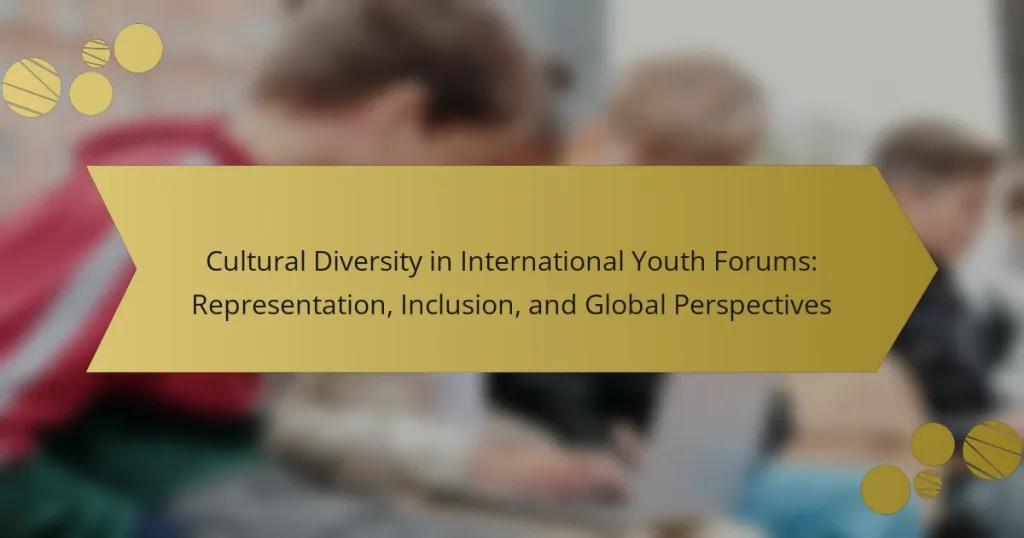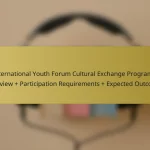Cultural diversity in international youth forums encompasses the involvement of participants from various cultural backgrounds, including different ethnicities, religions, and social contexts. This diversity enhances discussions on global issues, fostering mutual understanding and respect among cultures. Inclusion is crucial for ensuring that diverse voices are represented, leading to richer cultural exchanges and improved problem-solving outcomes. Best practices for promoting cultural diversity in these forums include creating inclusive policies, facilitating open dialogues, providing cultural competency training, and celebrating different cultures through various activities. These efforts contribute to a more collaborative and innovative environment, essential for addressing shared challenges on a global scale.
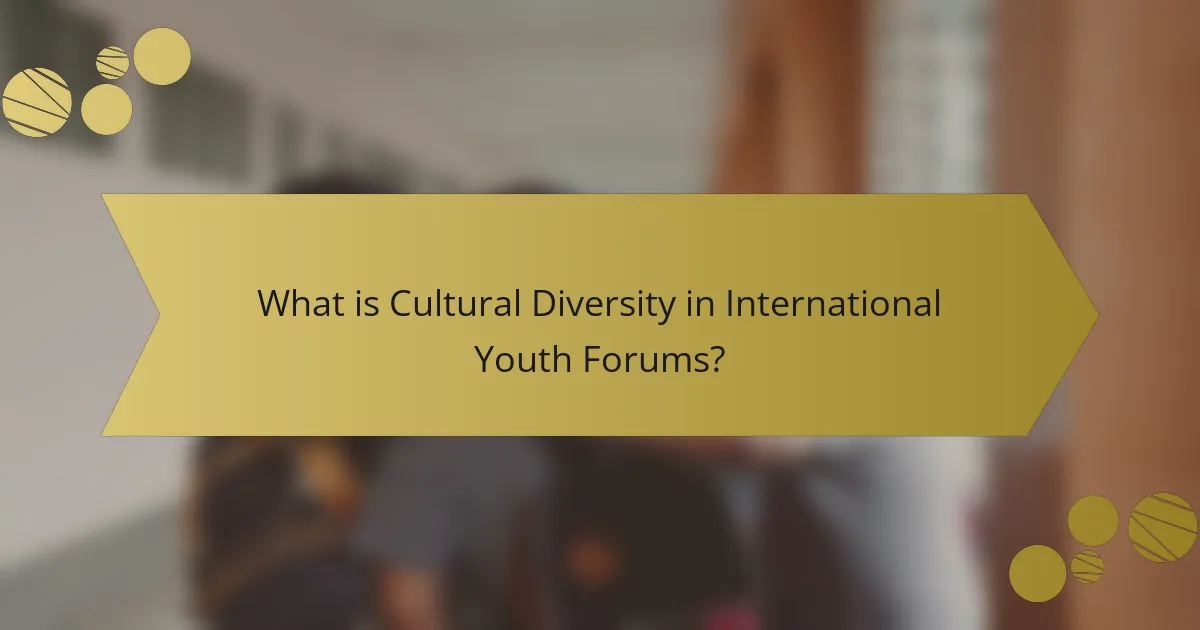
What is Cultural Diversity in International Youth Forums?
Cultural diversity in international youth forums refers to the presence and participation of various cultural backgrounds among youth participants. This diversity enriches discussions and perspectives on global issues. It fosters mutual understanding and respect among different cultures. Youth forums aim to include voices from diverse ethnicities, religions, and social backgrounds. This inclusion promotes collaboration and innovative solutions to shared challenges. Studies show that diverse groups lead to better problem-solving outcomes. Therefore, cultural diversity is essential for effective dialogue and cooperation in international youth forums.
Why is Cultural Diversity important in Youth Forums?
Cultural diversity is important in youth forums because it enhances representation and inclusion. Diverse perspectives foster creativity and innovation. Youth from various backgrounds contribute unique ideas and solutions. This leads to more comprehensive discussions and problem-solving. Cultural diversity also promotes understanding and respect among participants. It prepares youth for a globalized world. According to a study by the United Nations, inclusive forums increase engagement and participation among young people. Engaging with diverse cultures helps develop empathy and social skills.
How does Cultural Diversity enhance the dialogue in Youth Forums?
Cultural diversity enhances dialogue in youth forums by introducing varied perspectives. It allows participants to share unique experiences and insights. This exchange fosters mutual understanding and respect among youth from different backgrounds. Diverse viewpoints can lead to more creative solutions to common challenges. Research shows that diverse teams outperform homogeneous ones in problem-solving. For instance, a study by McKinsey found that companies with diverse teams are 35% more likely to outperform their peers. In youth forums, this translates to richer discussions and innovative ideas. Overall, cultural diversity is essential for effective communication and collaboration in these settings.
What are the challenges faced in promoting Cultural Diversity?
Promoting cultural diversity faces several significant challenges. One major challenge is the presence of stereotypes and prejudices. These biases can hinder open communication among different cultural groups. Another challenge is the lack of representation in decision-making processes. When diverse voices are not included, cultural perspectives are often overlooked. Additionally, economic disparities can limit access to resources for minority cultures. This can affect their ability to share their traditions and values. Language barriers also pose a significant obstacle. Misunderstandings can arise when individuals cannot communicate effectively. Finally, resistance to change within established institutions can impede efforts to embrace diversity. These challenges collectively hinder the promotion of cultural diversity in various contexts.
How is Representation achieved in International Youth Forums?
Representation in International Youth Forums is achieved through inclusive participation and diverse stakeholder engagement. These forums actively invite youth from various backgrounds to voice their perspectives. Representation is further facilitated by structured platforms for dialogue, ensuring all voices are heard. Organizers often implement selection processes that prioritize underrepresented groups. This approach addresses disparities in participation based on geography, gender, and socio-economic status. Additionally, partnerships with local organizations enhance outreach and inclusivity. Evidence of effective representation can be seen in forums that incorporate feedback mechanisms, allowing continuous improvement in engagement strategies. Such methods bolster the overall effectiveness of representation in these global discussions.
What criteria are used to ensure diverse representation?
Criteria for ensuring diverse representation include demographic diversity, which encompasses age, gender, ethnicity, and socioeconomic status. Representation must reflect the community’s composition to ensure inclusivity. Additionally, geographic diversity is essential, including participants from various regions and backgrounds.
The selection process often incorporates equitable access to opportunities for underrepresented groups. This may involve outreach efforts to engage marginalized communities. Another criterion is the alignment of participants’ experiences with the forum’s themes.
Lastly, representation should include a balance of perspectives, ensuring that voices from different cultural contexts are heard. These criteria are supported by frameworks advocating for inclusivity in decision-making processes.
How do different cultures influence the representation process?
Different cultures influence the representation process by shaping values, perspectives, and communication styles. Cultural norms dictate how individuals express their identities and viewpoints. For instance, collectivist cultures may prioritize group consensus over individual opinions. This can lead to different approaches in discussions and decision-making processes. Additionally, cultural backgrounds affect the interpretation of messages and symbols. Research indicates that cultural context can alter the understanding of representation in youth forums. A study by Hofstede (1980) highlights how cultural dimensions like individualism versus collectivism impact group dynamics. Thus, understanding these cultural influences is crucial for effective representation in international settings.
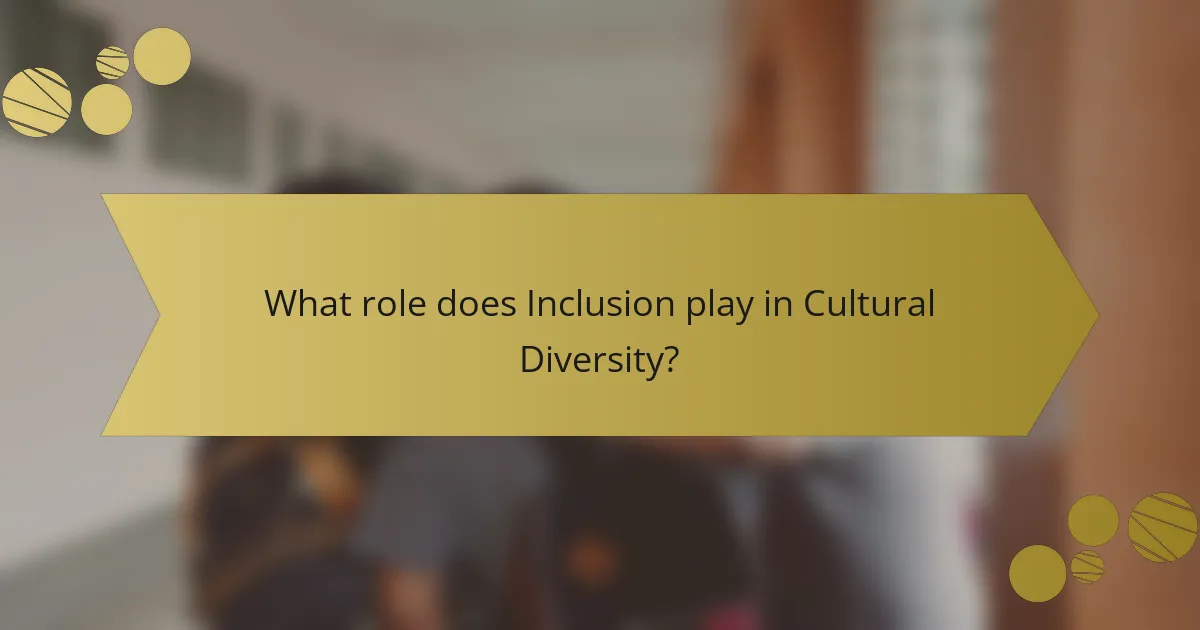
What role does Inclusion play in Cultural Diversity?
Inclusion is essential for fostering cultural diversity. It ensures that diverse voices are represented and heard. Inclusion allows individuals from various backgrounds to participate fully. This participation enhances the richness of cultural exchanges. Research shows that inclusive environments lead to greater creativity and innovation. According to a study by the McKinsey Global Institute, diverse teams are 35% more likely to outperform their peers. Inclusion also builds mutual respect and understanding among different cultures. This understanding is crucial for peaceful coexistence and collaboration.
How can Inclusion be measured in Youth Forums?
Inclusion in youth forums can be measured through various quantitative and qualitative metrics. Surveys can assess participants’ feelings of belonging and participation. Attendance data can reveal demographic diversity among youth participants. Focus groups can provide insights into individual experiences and perceptions of inclusion. Additionally, feedback forms can gauge satisfaction with the forum’s inclusivity practices. The analysis of these data points can help identify gaps and areas for improvement in fostering an inclusive environment.
What strategies promote Inclusion among participants?
Strategies that promote inclusion among participants include creating a welcoming environment and encouraging diverse perspectives. Establishing clear communication channels fosters engagement. Providing training on cultural competence enhances understanding among participants. Facilitating collaborative activities promotes teamwork and relationship-building. Implementing feedback mechanisms ensures all voices are heard. Offering resources in multiple languages accommodates diverse backgrounds. Regularly evaluating inclusion practices helps identify areas for improvement. These strategies collectively enhance participation and representation in diverse settings.
How do barriers to Inclusion affect participation?
Barriers to inclusion significantly hinder participation. These barriers can include physical, social, and systemic obstacles. Physical barriers may involve inaccessible venues or lack of transportation. Social barriers often stem from discrimination or lack of awareness. Systemic barriers include policies that do not support diverse participation. Research shows that marginalized groups face higher exclusion rates in various settings. For instance, a study by the National Council on Disability indicated that individuals with disabilities participate at lower rates due to accessibility issues. Consequently, these barriers limit the diversity and richness of discussions in youth forums.
Why are Global Perspectives essential in Youth Forums?
Global perspectives are essential in youth forums because they foster understanding and collaboration among diverse cultures. These perspectives allow young people to share unique experiences and viewpoints. Engaging with global issues helps participants develop critical thinking skills. It encourages empathy and respect for different backgrounds. Research shows that exposure to diverse opinions enhances problem-solving abilities. Youth forums that incorporate global perspectives promote inclusive dialogue. This inclusivity leads to innovative solutions for pressing social challenges. Ultimately, global perspectives enrich the learning experience for all participants.
How do Global Perspectives shape the outcomes of discussions?
Global perspectives significantly influence the outcomes of discussions by introducing diverse viewpoints. These perspectives enhance understanding and empathy among participants. They also encourage critical thinking, as individuals are exposed to different cultural contexts. Research shows that diverse groups often produce more innovative solutions. A study by Page (2007) in “The Difference: How the Power of Diversity Creates Better Groups, Firms, Schools, and Societies” supports this claim, indicating that diversity leads to superior problem-solving. Furthermore, incorporating varied perspectives fosters inclusivity, making all participants feel valued. This inclusivity can lead to more productive and meaningful discussions. Overall, global perspectives are crucial for achieving comprehensive and effective dialogue outcomes.
What impact do Global Perspectives have on local communities?
Global perspectives significantly influence local communities by fostering cultural exchange and understanding. They encourage local populations to engage with diverse ideas and practices. This engagement can lead to enhanced social cohesion and community resilience. Furthermore, exposure to global perspectives can inspire local initiatives that address universal challenges. For instance, communities may adopt sustainable practices learned from international counterparts. Research shows that communities embracing global perspectives often experience economic growth through increased tourism and trade. These interactions create opportunities for collaboration and innovation. Overall, global perspectives enrich local cultures and contribute to their development.
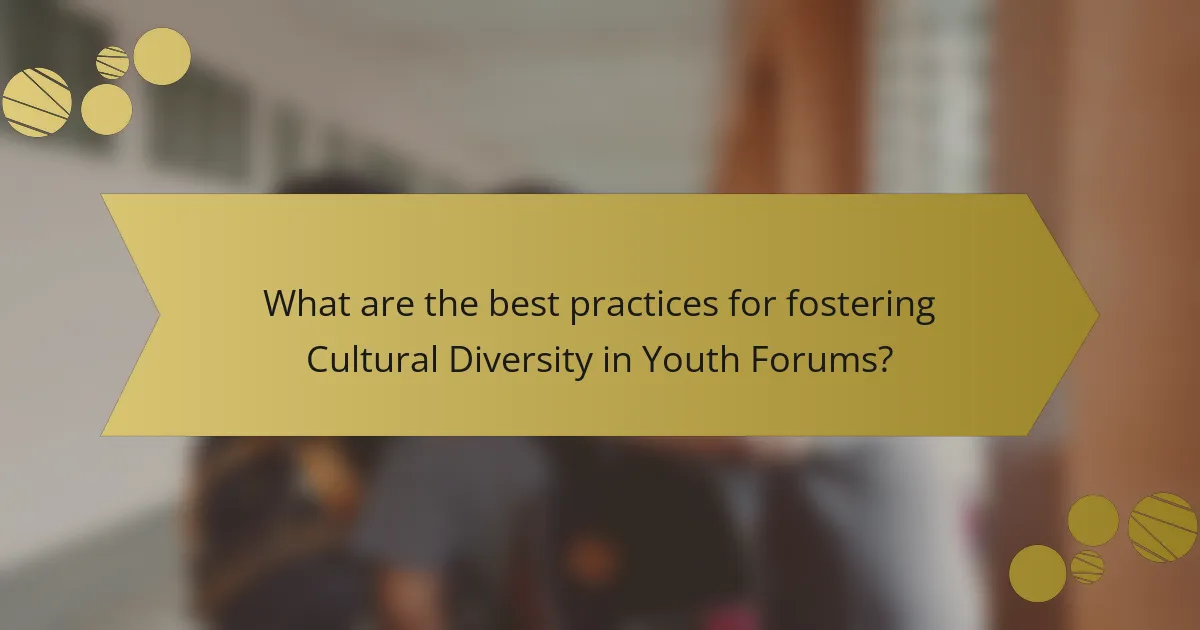
What are the best practices for fostering Cultural Diversity in Youth Forums?
Best practices for fostering cultural diversity in youth forums include creating inclusive policies and practices. Establishing guidelines that encourage participation from various cultural backgrounds is essential. Facilitating open dialogues allows youth to share their experiences and perspectives. Providing training for facilitators on cultural competency enhances understanding. Developing partnerships with diverse community organizations increases outreach and engagement. Implementing activities that celebrate different cultures promotes appreciation and respect. Regularly assessing the forum’s diversity initiatives ensures continuous improvement. These practices contribute to a richer, more inclusive environment for all participants.
How can organizers encourage broad participation?
Organizers can encourage broad participation by implementing inclusive outreach strategies. They should actively engage diverse communities to raise awareness about the event. Providing clear information about the benefits of participation can also motivate individuals. Offering incentives, such as scholarships or travel grants, can make participation more accessible. Utilizing social media platforms can help reach a wider audience effectively. Collaborating with local organizations can enhance trust and encourage involvement. Ensuring that the event is accessible for individuals with disabilities is essential. Finally, fostering a welcoming environment promotes a sense of belonging and encourages attendees to participate actively.
What tools can be used to facilitate diverse voices?
Digital platforms enable diverse voices to be heard effectively. Tools such as social media, online forums, and video conferencing facilitate communication across cultures. Social media platforms allow users to share experiences and perspectives instantly. Online forums create spaces for dialogue and discussion among diverse groups. Video conferencing tools enable real-time interaction, breaking geographical barriers. Surveys and polls gather feedback from various demographics, ensuring inclusivity. Collaborative tools like Google Docs allow for collective input on projects. These tools enhance representation and promote understanding among youth from different backgrounds.
How can feedback be utilized to improve future forums?
Feedback can be utilized to improve future forums by identifying participant needs and preferences. Gathering feedback through surveys or discussions highlights what worked well and what did not. This information allows organizers to make data-driven decisions for future events. For example, specific feedback on session topics can guide the selection of relevant themes. Additionally, understanding participant demographics can enhance representation and inclusion. Implementing changes based on feedback can lead to more engaging and effective forums. Research shows that participant satisfaction increases when feedback is actively used to shape future programming.
What common pitfalls should be avoided in promoting Cultural Diversity?
Common pitfalls to avoid in promoting cultural diversity include tokenism, stereotyping, and lack of genuine engagement. Tokenism occurs when organizations include individuals from diverse backgrounds only to appear inclusive, without meaningful participation. Stereotyping simplifies complex cultures into one-dimensional views, leading to misunderstandings. Lack of genuine engagement means failing to involve diverse voices in decision-making processes. According to a study by the American Psychological Association, inclusive practices improve group dynamics and creativity. Therefore, avoiding these pitfalls fosters a more authentic and effective promotion of cultural diversity.
How can organizers identify and address biases in forums?
Organizers can identify and address biases in forums by implementing structured feedback mechanisms. Surveys and anonymous questionnaires can reveal participants’ perceptions of bias. Analyzing participation data helps identify underrepresented groups. Regular training on cultural competency for organizers promotes awareness of biases. Facilitating open discussions encourages participants to voice concerns about bias. Reviewing forum content for language and representation highlights potential biases. Engaging diverse stakeholders in planning ensures multiple perspectives are considered. These methods collectively foster a more inclusive environment in forums.
What role does training play in overcoming cultural misunderstandings?
Training plays a crucial role in overcoming cultural misunderstandings. It equips individuals with the knowledge and skills necessary to navigate diverse cultural contexts. Effective training programs focus on cultural awareness, communication styles, and conflict resolution techniques. They help participants recognize their own cultural biases and assumptions. Research shows that organizations implementing cross-cultural training experience improved team dynamics and collaboration. For example, a study by the Society for Human Resource Management found that 75% of companies reported better employee relations after cultural training. This highlights the importance of training in fostering understanding and reducing conflicts arising from cultural differences.
Cultural diversity in international youth forums refers to the inclusion and participation of various cultural backgrounds among youth participants, enhancing discussions and fostering mutual understanding. This article explores the importance of cultural diversity, the challenges faced in promoting it, and the criteria for ensuring diverse representation. It also examines the role of inclusion in fostering cultural diversity, strategies to measure and promote it, and the impact of global perspectives on discussions and local communities. Best practices for fostering cultural diversity and common pitfalls to avoid in this context are highlighted, providing a comprehensive overview of how cultural diversity can be effectively integrated into youth forums.
